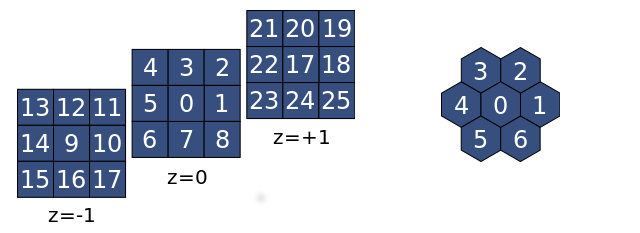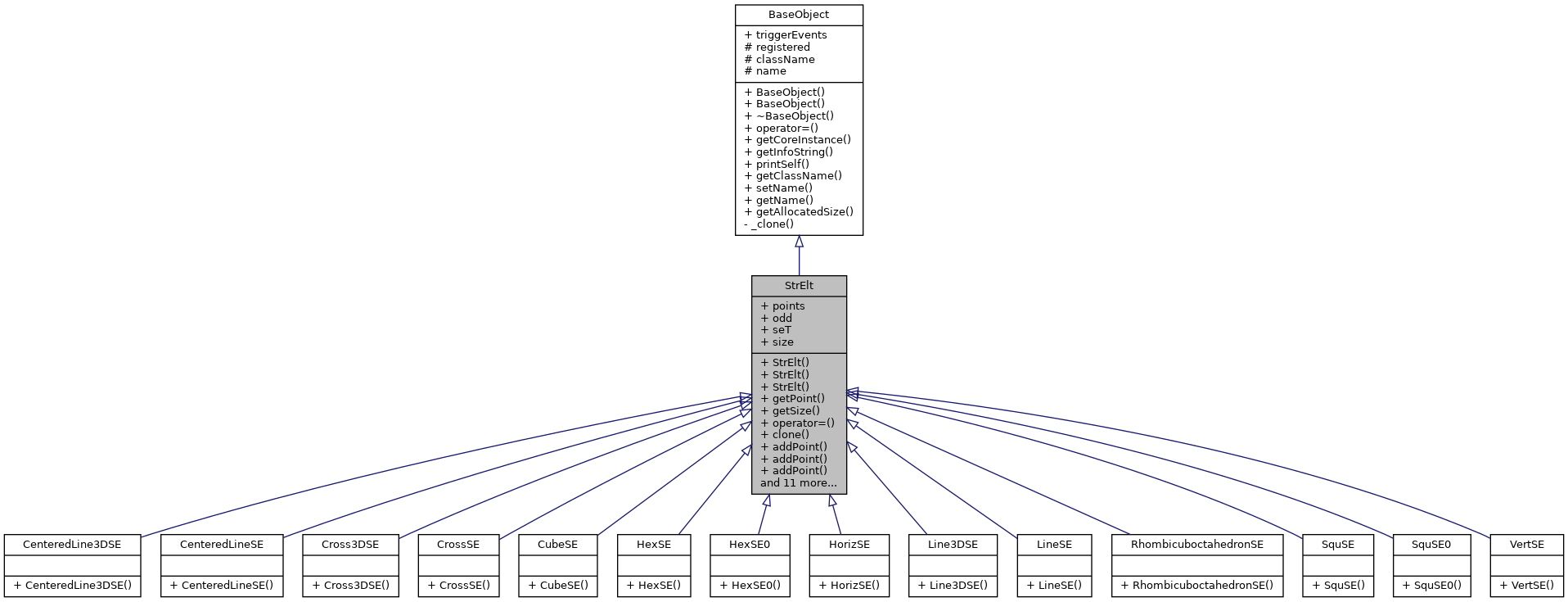Base structuring element. More...
Detailed Description
Base structuring element.
#include <DStructuringElement.h>
 Inheritance diagram for StrElt:
Inheritance diagram for StrElt: Collaboration diagram for StrElt:
Collaboration diagram for StrElt:Public Member Functions | |
| StrElt (UINT s=1) | |
| Class constructor - generic structurant element. | |
| StrElt (const StrElt &rhs) | |
| Class constructor - clone another structuring element. | |
| StrElt (bool oddSE, vector< UINT > indexList) | |
| Class constructor. | |
| IntPoint | getPoint (const UINT i) |
getPoint() - Get the coordinates (as a point) of the pixel of order i in the structuring element | |
| UINT | getSize () const |
| getSize() - Get the size of the Structuring Element | |
| StrElt & | operator= (const StrElt &rhs) |
| Clone a structuring element. | |
| void | clone (const StrElt &rhs) |
| clone() - Clone a structuring element | |
| void | addPoint (const UINT index) |
| addPoint() - Add a point to the structurant element based on an index on a grid. | |
| void | addPoint (int x, int y, int z=0) |
| addPoint() - Add a point to the structurant element given its coordinates | |
| void | addPoint (const IntPoint &pt) |
addPoint() - Add a point to the structurant element given its coordinates in a IntPoint data structure. | |
| const StrElt | operator() (int s=1) const |
| operator() - | |
| StrElt | homothety (const UINT s) const |
| homothety() - Build and return an homothetic SE with size s | |
| StrElt | transpose () const |
| transpose() - Return the opposite SE (symmetry with respect to 0) | |
| StrElt | merge (const StrElt &rhs) |
| merge() - Merge a structuring element | |
| StrElt | noCenter () const |
| Return the SE with no center. | |
| virtual seType | getType () const |
| getType() - Get the type of the structuring element | |
| void | setName (string name) |
| setName() - Set the name of the structuring element | |
| void | setName () |
| setName() - Set the name of the structuring element | |
| const char * | getName () const |
| getName() - Get the name of the structuring element | |
| virtual void | printSelf (ostream &os=std::cout, string indent="") const |
| printSelf() - Print the contents of the structuring element | |
| virtual void | printSelf (string indent) const |
| printSelf() - Print the contents of the structuring element | |
Public Attributes | |
| vector< IntPoint > | points |
| List of neighbor points. | |
Constructor & Destructor Documentation
◆ StrElt() [1/3]
|
inline |
Class constructor - generic structurant element.
- Parameters
-
[in] s : size of the structinrg element
◆ StrElt() [2/3]
Class constructor - clone another structuring element.
- Parameters
-
[in] rhs : structuring element
◆ StrElt() [3/3]
|
inline |
Class constructor.
Construct a structuring element with points defined by their indexes.
- Parameters
-
[in] oddSE : Specify if we want to use an hexagonal grid (true) or a square grid (false) [in] indexList : The list of point indexes
The index values are defined for each grid type as follow:

Example:
Member Function Documentation
◆ getPoint()
|
inline |
getPoint() - Get the coordinates (as a point) of the pixel of order i in the structuring element
- Parameters
-
[in] i : pixel index
- Returns
- the coordinates of the pixel, relative to the StrElt center
◆ getSize()
|
inline |
getSize() - Get the size of the Structuring Element
- Returns
- the size of the structuring element
◆ operator=()
Clone a structuring element.
Clone a strunturing element to, eventually, create another one based on it.
Example:
◆ clone()
| void clone | ( | const StrElt & | rhs | ) |
clone() - Clone a structuring element
- Parameters
-
[in] rhs : structuring element to be cloned
◆ addPoint() [1/3]
| void addPoint | ( | const UINT | index | ) |
addPoint() - Add a point to the structurant element based on an index on a grid.
Index are defined as in the following drawings :
- Grids : Square and Hexagonal

- Parameters
-
[in] index : index to predefined point coordinates, as above.
Example:
◆ addPoint() [2/3]
| void addPoint | ( | int | x, |
| int | y, | ||
| int | z = 0 |
||
| ) |
addPoint() - Add a point to the structurant element given its coordinates
- Parameters
-
[in] x,y,[z] : point coordinates
◆ addPoint() [3/3]
| void addPoint | ( | const IntPoint & | pt | ) |
addPoint() - Add a point to the structurant element given its coordinates in a IntPoint data structure.
- Parameters
-
[in] pt : a point to be added to the structuring element (itself)
◆ homothety()
| StrElt homothety | ( | const UINT | s | ) | const |
homothety() - Build and return an homothetic SE with size s
- Parameters
-
[in] s : size of the new structuring element
- Returns
- a structuring element of size s
◆ transpose()
| StrElt transpose | ( | ) | const |
transpose() - Return the opposite SE (symmetry with respect to 0)
- Returns
- a structuring element
◆ merge()
merge() - Merge a structuring element
- Parameters
-
[in] rhs : structuring element to be merged
- Returns
- a structuring element
◆ noCenter()
| StrElt noCenter | ( | ) | const |
Return the SE with no center.
Remove the central point of the Structuring Element
- Returns
- a structuring element
◆ getType()
|
inlinevirtual |
getType() - Get the type of the structuring element
- Returns
- the content of the seT private field
◆ setName() [1/2]
|
inline |
setName() - Set the name of the structuring element
- Parameters
-
[in] name - the new name
◆ setName() [2/2]
|
inline |
setName() - Set the name of the structuring element
Set the structuring element based on the type field seT
◆ getName()
|
inlinevirtual |
getName() - Get the name of the structuring element
- Returns
- the name of the structuring element (as a string)
Reimplemented from BaseObject.
◆ printSelf() [1/2]
|
virtual |
printSelf() - Print the contents of the structuring element
- Note
- In Python this has the same effect than print(se)
Reimplemented from BaseObject.
◆ printSelf() [2/2]
|
inlinevirtual |
printSelf() - Print the contents of the structuring element
- Note
- In Python this has the same effect than print(se)
The documentation for this class was generated from the following files:
- Morpho/include/DStructuringElement.h
- Morpho/src/DStructuringElement.cpp

